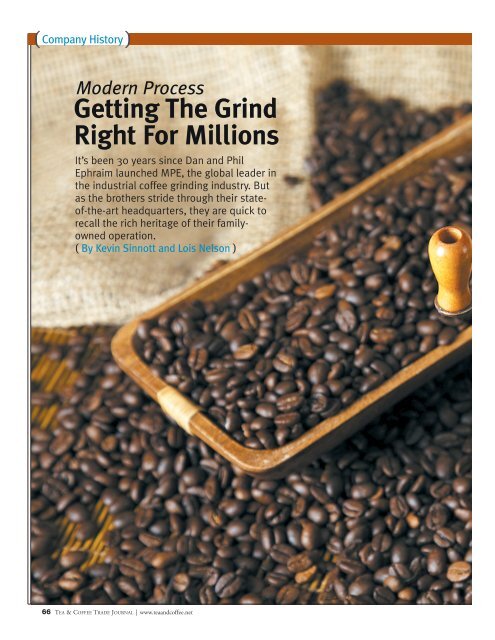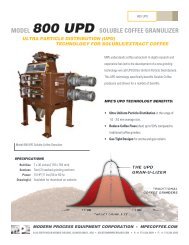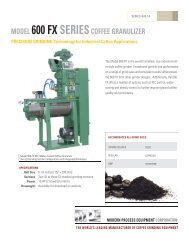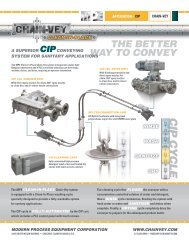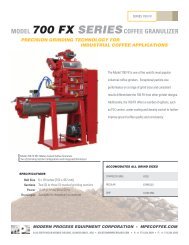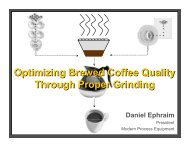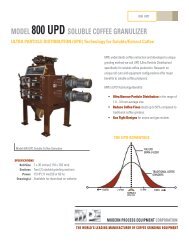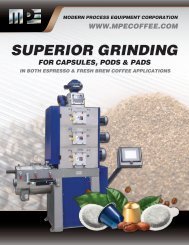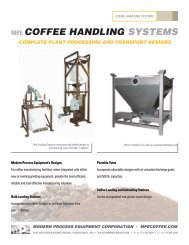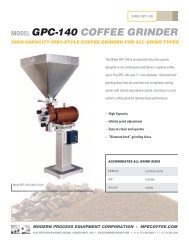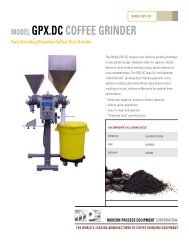Modern Process Getting The Grind Right For Millions
Modern Process Getting The Grind Right For Millions
Modern Process Getting The Grind Right For Millions
You also want an ePaper? Increase the reach of your titles
YUMPU automatically turns print PDFs into web optimized ePapers that Google loves.
( Company History )<br />
<strong>Modern</strong> <strong>Process</strong><br />
<strong>Getting</strong> <strong>The</strong> <strong>Grind</strong><br />
<strong>Right</strong> <strong>For</strong> <strong>Millions</strong><br />
It’s been 30 years since Dan and Phil<br />
Ephraim launched MPE, the global leader in<br />
the industrial coffee grinding industry. But<br />
as the brothers stride through their stateof-the-art<br />
headquarters, they are quick to<br />
recall the rich heritage of their familyowned<br />
operation.<br />
( By Kevin Sinnott and Lois Nelson )<br />
66 TEA & COFFEE TRADE JOURNAL | www.teaandcoffee.net
APRIL 2012 67
( Company History )<br />
With customers in over 50 countries,<br />
MPE is the world’s standard<br />
in industrial coffee grinding<br />
systems. But their international base<br />
of operation is firmly rooted in the soil of<br />
Chicago’s South Side — not far from<br />
where the brothers grew up in a family of<br />
nine children.<br />
Dan was an executive in a coffee company,<br />
and his brother, Phil, a mechanical<br />
engineer for another manufacturing corporation,<br />
when they decided it would be<br />
smart to buy a company where they could<br />
combine their entrepreneurial and engineering<br />
expertise. When Dan first spotted<br />
a small company named <strong>Modern</strong> <strong>Process</strong><br />
for sale in 1981, he quickly recognized it<br />
could be a big thing. He had no idea just<br />
how big.<br />
<strong>Modern</strong> <strong>Process</strong> was founded in 1957<br />
by Don Stage and Roger Fardig who remanufactured<br />
Gump <strong>Grind</strong>ers, perhaps the best<br />
grinders of the day. Business was good – but<br />
they never wanted to get too big, fearing<br />
that large competitors would rise up and<br />
swallow them. Silently, they grew and captured<br />
most of the grinder remanufacturing<br />
business in North America. Just as quietly,<br />
they put the company up for sale.<br />
“We always talked about going into<br />
business together,” Phil says, “and Dan<br />
knew the coffee business. I came down<br />
with our father to look at the company.<br />
Dad turned to us said, ‘Boys, this looks<br />
like a great business, buy it.’”<br />
“So I said, ‘let’s jump.’”<br />
With their father’s blessing and support,<br />
Phil and Dan made the bold move to<br />
buy in a depressed economic climate; interest<br />
rates were 21%, unemployment was<br />
10.5% and inflation had soared to over<br />
13%. <strong>The</strong> brothers received an industrial<br />
revenue bond from the City of Chicago —<br />
and begged and borrowed the rest.<br />
Within months, they moved into the<br />
small shop and started designing and<br />
building equipment that would revolutionize<br />
the world of coffee grinding.<br />
Constantly Changing <strong>The</strong>ir <strong>Grind</strong>s<br />
As the technology of grinding has changed<br />
dramatically during the past three decades,<br />
so has the company’s leadership.<br />
As Dan begins, “When the company<br />
An early photo of Phil and Dan with one of the original Gump-Style units<br />
first began, most of grinding was percolator,<br />
some was instant or soluble and the<br />
remainder vacuum, popularly called Silex.<br />
During the 1990s, Espresso grew from 2-<br />
3% to 5-10%, depending on how you<br />
measure it. Today, drip holds steady at 70-<br />
80% and other grinds at 20%.”<br />
Lizzie Ephraim was only a year old<br />
when her dad, Dan, launched MPE. Today,<br />
she’s the director of marketing and the company’s<br />
spokesperson who can expound on<br />
the evolution of the grinding business.<br />
“With changing technology, demands<br />
continue to increase. Making a coarse<br />
grind is relatively easy,” says Lizzie, whose<br />
technical knowledge clearly demonstrates<br />
her Ephraim DNA. “However, as you<br />
achieve a finer and finer grind, the<br />
demand on a grinder is greater, and the<br />
sophistication of the grinder becomes<br />
higher. So a grinder that is produced for<br />
coarse grinds will last three or four times<br />
as long between services and reconditioning<br />
as one that’s grinding a fine grind.”<br />
Dan continues, “Today’s brewing<br />
methods can be more efficient. <strong>The</strong> brewers<br />
are better and the controls are better<br />
so that you can make your coffee somewhat<br />
finer, getting extra extraction for the<br />
same amount of ground coffee, even<br />
urns. Yesterday’s urns used a coarser<br />
grind, more towards a French Press grind.<br />
Today, when you see an urn in a facility<br />
like McDonald’s, it typically takes a finer,<br />
drip grind.”<br />
Staying Ahead Of <strong>The</strong> <strong>Grind</strong><br />
<strong>The</strong>re are other brewing methods that<br />
challenge grinding technologies such as<br />
the new pod brewing business, which has<br />
enormous consumer appeal.<br />
“To us, the pod business has become<br />
very significant,” Dan continues. “You’re<br />
now taking the brew method that typically<br />
takes four minutes and saying, ‘Okay,<br />
I’m going to have a pod coffee in 20 seconds.’<br />
It’s incredible how much more<br />
sophisticated the grind has to be.”<br />
Phil adds, “With pods, the size gets<br />
smaller, but so do tolerances. We have to be<br />
careful because the brew time and portion<br />
size gets very specific. It is truly a science.”<br />
Phil points to an ancient method as<br />
taxing as any domestic grind, in fact more<br />
so. “<strong>The</strong> finest grinds we do are neither<br />
pods nor espresso. Turkish grinding is a<br />
specialty for us too.”<br />
MPE sells to industrial users who evaluate<br />
product efficiences with very tight<br />
tolerances. Dan is quick to point out that<br />
68 TEA & COFFEE TRADE JOURNAL | www.teaandcoffee.net
( Company History )<br />
industrial evolution, not a specific brewing<br />
method, is responsible. “<strong>Grind</strong>s in<br />
general keep getting finer, and people<br />
want zero waste. People won’t deal with<br />
something that’s 60% efficient anymore.<br />
<strong>The</strong>y want 95 – 100%.”<br />
<strong>The</strong> Clear Frontrunner<br />
With the fact that every cup of coffee<br />
requires grinding coffee, when it comes to<br />
industrial grinding, <strong>Modern</strong> <strong>Process</strong> is<br />
clearly out front.<br />
“In the United States, we are the sole<br />
manufacturer of industrial coffee<br />
grinders,” states Lizzie. “How much of<br />
our business a number of years ago was<br />
overseas? Minimal. Now, it’s a very significant<br />
portion.”<br />
Dan cites an early startup customer:<br />
“When the leading coffee shop brand was<br />
just a three-shop operation, we were their<br />
supplier. We sold them their first grinder.”<br />
Phil fires the punch line, “And they’re still<br />
An early photo of Phil and Dan with one of the original Gump-Style units<br />
More Than A Cup Of Coffee<br />
MPE builds and develops a myriad of systems<br />
supporting coffee grinders, including<br />
conveying systems.<br />
“Now, our customers want us to<br />
design, incorporate and integrate all the<br />
moving parts. So, we integrate the silos,<br />
weighing systems, blending systems as<br />
well as the other parts of a factory. We’ve<br />
built the process systems for some of the<br />
biggest factories in the country.”<br />
But the business extends beyond the<br />
grinding of coffee beans. In fact, anything<br />
that’s ground or ‘granulized’ is a potential<br />
<strong>Modern</strong> <strong>Process</strong> customer. This includes<br />
salt and spices – and extends to other food<br />
and chemical products.<br />
An early photo of Phil and Dan with one of the original Gump-Style units<br />
our customer.”<br />
“Internationally, grinding for instant<br />
coffee continues to be a big business and<br />
we continue to make the special grinders<br />
for this market. In fact, last week we<br />
shipped an entire system for a company in<br />
Vietnam that’s building an instant coffee<br />
production plant.”<br />
Service Makes <strong>The</strong> Difference<br />
Paramount to being the technology leader<br />
is catering to a global network of customers<br />
with ever-demanding needs for service.<br />
“We don’t have a service department that<br />
just kicks it down the road,” says Phil. “We<br />
take it very personally when somebody calls<br />
us up to report an issue. We know them and<br />
we want to to fix it. Whether that’s a<br />
$10,000 grinder or $300,000 grinder, we<br />
want that problem to be solved.”<br />
Phil motions to a suitcase partially<br />
APRIL 2012 69
( Company History )<br />
obscured by a cubicle wall. “Today I’m<br />
headed to Israel, with 2,000 pounds of<br />
parts to help a customer. We paid for<br />
those to be flown over.”<br />
Dan adds, “<strong>The</strong>y’re our customer and<br />
we want to take care of them.”<br />
Lizzie sums it up: “In business, people<br />
like dealing with us and have a high level<br />
of confidence in us.”<br />
Considered by many to be the U.S.’<br />
Boeing equivalent in the coffee industry,<br />
Dan says, “We never forget the importance<br />
of our customer relations.”<br />
A Gentler Way To Move A Bean<br />
So how does an industrial coffee grinding<br />
company expand its market reach? By creating<br />
a new market opportunity, of course.<br />
MPE makes no secret that their love<br />
of new products and ratchet tweaking has<br />
led to their newest breakthrough technology<br />
— one suited to coffee, as well as<br />
other products. It’s called Chain-Vey, and<br />
Dan describes the potential for this product<br />
line in one word. Tremendous.<br />
“It’s significant,” Dan adds, “because<br />
<br />
<br />
<br />
<br />
<br />
<br />
<br />
<br />
Max, Dan and Phil Ephraim<br />
it’s an enclosed tube and a really gentle<br />
way to move products around. It’s great<br />
for whole bean, green and roasted, as well<br />
as ground coffee. <strong>The</strong> idea of a sealed, airless<br />
container traveling around a plant is<br />
very attractive for a lot of products.”<br />
Lizzie snaps a coffee bean between her<br />
fingers showing how easy it is for effect,<br />
“It doesn’t break up the whole bean”<br />
It’s <strong>The</strong>ir Kind Of Town<br />
<strong>The</strong> one thing that isn’t changing anytime<br />
in the foreseeable future at <strong>Modern</strong><br />
<strong>Process</strong> is the company’s loyalty to its<br />
hometown manufacturing base.<br />
Dan doesn’t hedge, “All our manufacturing<br />
is done right here in the U.S., and<br />
we want to keep everything here.”<br />
“<strong>Right</strong> here in Chicago,” adds Lizzie,<br />
again without hesitation.<br />
<strong>For</strong> two decades, her grandfather, Max<br />
Ephraim, served as chairman of the board<br />
and provided wise counsel. After he retired<br />
as chief engineer for a General Motors<br />
Division, he spent every Thursday at the<br />
factory. “He knew more about our workers<br />
and their families than we did,” says Phil.<br />
Max passed away 10 years ago, but<br />
the values he instilled in his sons and<br />
granddaughter continue to produce<br />
amazing results.<br />
Lizzie continues, “Dan and Phil come<br />
from a family of nine. But when it comes<br />
to large families, there’s no contest here.<br />
We have guys in the plant who come from<br />
families even larger. We didn’t plan it that<br />
way, but we love big families and we think<br />
that our focus on family fosters growth<br />
within our organization.”<br />
To encourage their employees’ health<br />
and wellness, MPE recently installed a<br />
state-of-the art workout and fitness area.<br />
And holidays celebrations — complete<br />
with grab gifts, turkeys and hams — are a<br />
highlight for the entire company.<br />
Dan smiles broadly, “Every year, we<br />
throw a Christmas party and honor our<br />
employees with a great dinner, bonuses<br />
based on performance and gifts. This past<br />
Christmas, I think we were all looking in<br />
amazement as we saw how many people<br />
have been here for a long tine. <strong>The</strong>y are a<br />
part of all this success and our vision for<br />
the future.”<br />
“<strong>The</strong> same place for 30 some years,”<br />
Phil reflects. “I remember when the first<br />
employee hit 15 or 20 years. Now<br />
there’s a number of them with 25 years<br />
right here in our building. <strong>The</strong>y’re part<br />
of our family.”<br />
“This has always been a family-oriented<br />
business,” Dan responds. “It’s such a<br />
part of who we are – and it’s key to our<br />
success.”<br />
“It always has been, and always will<br />
be,” says Lizzie with a smile.<br />
70 TEA & COFFEE TRADE JOURNAL | www.teaandcoffee.net


